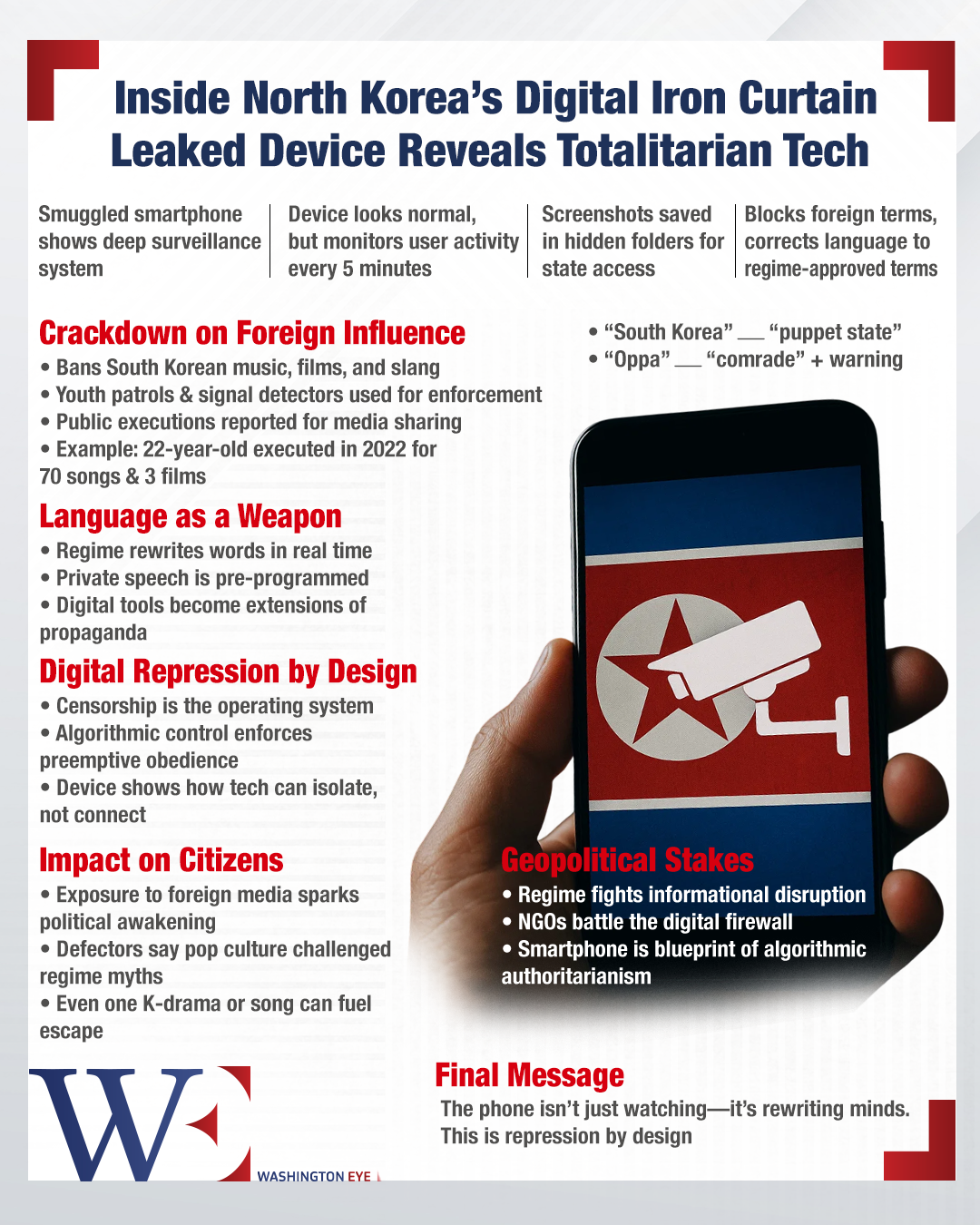A smuggled smartphone from North Korea has provided an unprecedented glimpse into the regime’s sophisticated digital surveillance and censorship mechanisms. The device, which was clandestinely transported out of the country, reveals the extent to which the North Korean government goes to control information and suppress foreign influence.
A Glimpse into the Regime’s Surveillance Tactics
The smartphone, indistinguishable in appearance from standard devices, is embedded with intrusive software designed to monitor and control user activity. It automatically censors content, blocks the use of South Korean language, and monitors users in real-time without their awareness. The device takes screenshots every five minutes, storing them in hidden folders accessible only to state authorities. These measures ensure that any attempt to access unauthorized content is swiftly detected and punished.
Furthermore, the phone’s software automatically corrects certain South Korean terms to regime-approved language. For instance, typing “South Korea” results in an automatic correction to “puppet state”, a derogatory term used by the regime. Similarly, the word “oppa”, a common South Korean expression for an older brother or boyfriend, is forcibly changed to “comrade”, accompanied by a warning that the term can only be used to describe siblings.
The Regime’s War on Foreign Influence
North Korea’s leadership has long viewed foreign media, particularly from South Korea, as a threat to its ideological control. In response, the regime has intensified its efforts to prevent the infiltration of foreign content. This includes the deployment of handheld signal detectors to crack down on unauthorized phone calls to South Korea and the establishment of youth patrol squads to enforce linguistic and cultural restrictions.
The consequences for violating these restrictions are severe. A human rights report by South Korea’s Unification Ministry revealed that North Korean authorities publicly executed a 22-year-old man for listening to and sharing South Korean music and films. The man was killed in 2022 for listening to 70 South Korean songs and watching three films, which he then distributed, thus violating a North Korean law adopted in 2020 that bans “reactionary ideology and culture”.
The Implications of Digital Repression
The revelations from the smuggled smartphone underscore the regime’s commitment to maintaining an information monopoly. By leveraging modern technology for surveillance and propaganda, North Korea aims to reinforce indoctrination and suppress dissent. This digital repression not only infringes on individual freedoms but also isolates the population from the global community.
Despite these efforts, there is evidence that exposure to foreign media can have a profound impact on North Korean citizens. Former North Korean dissident Kang Gyuri, who fled in 2023, revealed that exposure to foreign media shattered her perception of normalcy under the regime, fueling her determination to escape.
A Final Note
The leaked smartphone is not just a tool of repression—it is a blueprint for digital totalitarianism. What makes this revelation so significant is not merely the existence of censorship, which is already well-documented in North Korea, but the systematic integration of state ideology into the very mechanics of personal technology. The regime is not only surveilling behavior but preemptively rewriting language, intention, and interaction in real time. This level of control, where even private language is regimented, marks a chilling evolution from traditional propaganda to a form of algorithmic authoritarianism.
What’s more, the device demonstrates how North Korea has adapted to the realities of the 21st century—not by opening up, but by mastering digital tools to reinforce isolation. While autocratic states across the world are grappling with the disruptive potential of information, Pyongyang has gone a step further: it’s attempting to render disruption impossible through design.
Yet this tightly woven web is inherently fragile. The very need to enforce such granular controls speaks to an underlying fear—that exposure to the outside world, even in small doses, could unravel the ideological fabric of the regime. And they are right to be afraid. Testimonies from defectors consistently show that even brief encounters with South Korean media—be it a K-drama, pop song, or bootleg film—can spark political awakening. Media, in this context, is not merely entertainment; it is counterrevolutionary.
The geopolitical implications are also stark. While South Korean and international NGOs continue their efforts to penetrate this information blockade, the regime’s digital fortress becomes both a symbol and a battlefield in a modern cold war of narratives. In an age where connectivity defines development and global belonging, North Korea is doubling down on informational seclusion—at the cost of its people’s intellectual freedom and dignity.
In short, the smartphone isn’t just a device. It is a warning. It shows us what it looks like when surveillance isn’t just reactive but preemptive, when censorship is not the exception but the operating system. And perhaps most importantly, it reminds us that in regimes like North Korea, the control of media is not about protecting citizens—it is about protecting power.
















